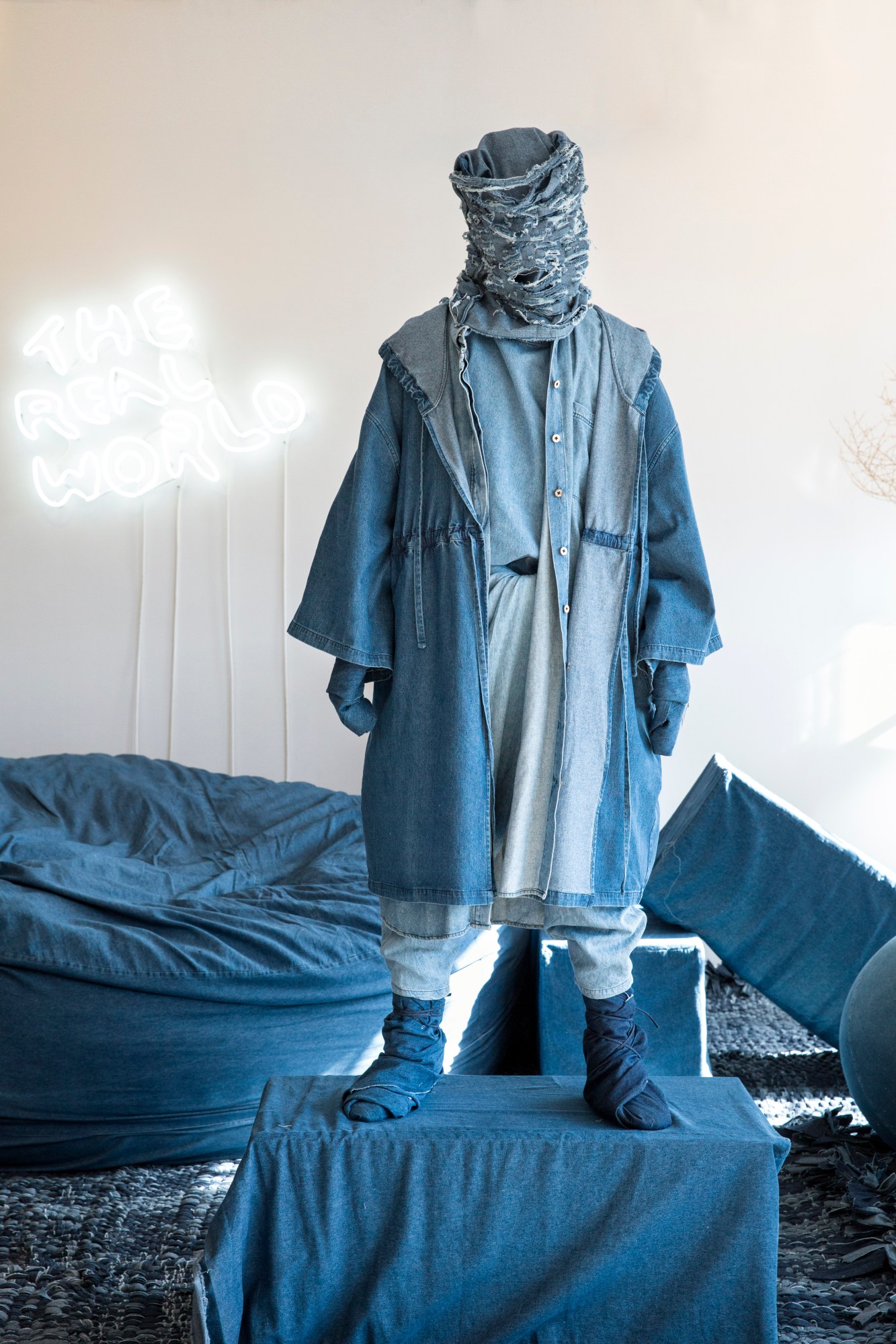The ideal of authorlessness that 69 professes isn’t defensively conspiratory like Anonymous, nor is it self-mythologising like Martin Margiela—it’s more California spiritual, about the absolution of the ego, freedom of perception, and self-actualisation. Anonymity, 69 says, allows them privacy and space to create without tripping over self-image. “Who I am personally,” they stated, “shouldn’t interfere with people’s perception of what I make. I am a vessel. I’m compelled to make my ideas realities.”
69’s ideas are realised in clothes. They make “non-demographic” classics out of comfortable, durable fabrics like denim, linen, and cotton jersey. Their cuts are oversized

and styled unisex. Dresses and suits display the same androgynous excess. Garments hang from shoulders or hips; beneath, the body moves unencumbered.
The shelter 69’s clothes provide is that of a beach cabana: adaptable, airy, and relaxed, ideal for LA’s dry desert heat. There’s a monastic quality to the look too, robes seemingly inspired by Buddhist Kashaya and California’s Father Yod and the Source Family. One coat from spring/summer 15 comes topped with a Pope-style capelet. In denim though, stonewashed or bleached, the mode is secular, and it’s not without sexiness: 69’s indefinite shapes may neutralise gender, but in them, the wearer feels herself naked, skin sensual against textile.
69 was launched in 2011 with a small collection titled Summer of 69 ’12. That season introduced a number of basics the brand continues to manufacture, among them “the Everything Dress,” “the Cocoon Dress,” and “the Dad Pants.” Assembly New York was the line’s first buyer. Since then, 69 has gone on to retail at Opening Ceremony, Creatures of Comfort, Australia’s Dagmar Rousset, and many stores in Japan. The brand also maintains an interactive online shop, which ships directly from Los Angeles, where the clothes are produced.
Though the designer insists that, “69 cannot be categorised in any time or place,” its style has nostalgia. I’m reminded in the oversized natural fibers of Issey Miyake’s Plantation line and Will Smith’s Williwear. While the collection “ads” (original images disseminated, in 21st century fashion, through social media) look like they could’ve been printed in Wet Magazine or early issues of Details. What’s new in fashion is the brand’s casting; their models make Benetton’s diversity look like a Whit Stillman film. People of many sizes, ages, and skin tones are photographed with a like affection, eternal beauty exposed.
I’ve met the person who makes 69. We lounged just us two for an hour in their Downtown LA studio this summer. The meet was a social call. We were set up by mutual friends. Then, I knew the brand, but not the story of anonymity; that they considered a success. In their studio overlooking the Fashion District of Downtown, we discussed tattoos as personal symbology, Winona Ryder, Korean spas, and urbanite fantasies of living off-center. While laying on a broad mound of denim-clad foam (nearly everything in 69’s studio is upholstered in denim, from pot holders to a pilates ball) I guessed 69’s sign, Cancer, from their logo.
The symbol for Cancer, the fourth sign in the zodiac, looks like a reclining 69. Cancers are associated with reclusivity and/or domesticity; the designer identified with the latter. “But like a crab,” they shared, “I take my home wherever I go. My denim book bag has everything I need in it.”
69’s commitment to anonymity is anomalous to our times, when individuals in all markets are encouraged to “self-brand.” Persona sells yoghurt, underwear, water, fashion, and especially art. To not participate can limit your market value. Or, as with Banksy and Margiela, mystery ends up defining—and selling—your work. “Fuck ALL that mess,” 69 says. In anonymity, they seek privacy, not publicity. “I have a next-to-nothing social life,” they insist. “I tiptoe.”
Blankness and openness are synonymous in 69. The anonymity the designer wears is spacious like the garments they make; it makes room for their creativity and ours. We make of 69 what we will.
Credits
Text Fiona Duncan
Photography Alex Aristei
